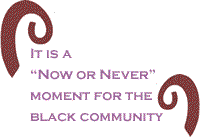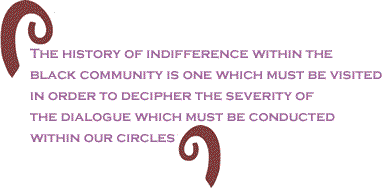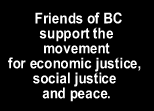The black
community has always had the weighty challenge of dealing
with a minority within its populace which functioned in a
way that was antithetical to its unity and progress. The only
difference between then and now is that now, the vast majority
of blacks have become regrettably numb and immune to the pain
of their own fellow-brothers and sisters.  Having
endured the brutal dilemma of American enslavement, coupled
with the history of neglect by 911 operators and police officers,
it is understandable for a generation to be consciously tone
deaf, but such an excuse is only valid for a limited amount
of time. Apathy within the black community is like cancer
in the system of a new born baby – before long, reality will
set in. We have allowed the incessant travails of black life
to silence our moral responsibility for taking of each other.
Malcolm X would be displeased, Du Bois would weep, and Dr.
King would lament this misfortune. The history of indifference
within the black community is one which must be visited in
order to decipher the severity of the dialogue which must
be conducted within our circles.
Having
endured the brutal dilemma of American enslavement, coupled
with the history of neglect by 911 operators and police officers,
it is understandable for a generation to be consciously tone
deaf, but such an excuse is only valid for a limited amount
of time. Apathy within the black community is like cancer
in the system of a new born baby – before long, reality will
set in. We have allowed the incessant travails of black life
to silence our moral responsibility for taking of each other.
Malcolm X would be displeased, Du Bois would weep, and Dr.
King would lament this misfortune. The history of indifference
within the black community is one which must be visited in
order to decipher the severity of the dialogue which must
be conducted within our circles.

One of
the earliest recollections of “coldness” within our community
is the tragedy of Kitty
Genovese. She was a New York City Woman who was stabbed
numerous times and sexually-assaulted over the time span of
half an hour. An additional blow was dealt when the public
realized that her screams of “Oh my God, he stabbed me! Help
me!” were largely ignored by the immediate neighbors and passers-by.
Sadly, this incident would not close the curtain on apathy
from within the Black and Brown communities.
 On
August 24, 2007, CBS
News reported the rape and pillage of a 26-year-old woman
without any intervention from the well-aware neighbors. The
local prosecutors spoke of a security video which showed how
“at least 10 witnesses ignored a woman’s cries for help for
more than an hour as a man beat and sexually assaulted her.”
The Police spokesman elaborated on it saying, “The surveillance
video clearly showed men and women looking out their apartment
doors or starting to walk down the hallway before retreating
as the woman was assaulted for nearly 90 minutes… The video
shows one person looking out of her door probably three times.
It shows another person walking up, observing what’s going
on, then turning and putting up the hood of his sweatshirt.”
On
August 24, 2007, CBS
News reported the rape and pillage of a 26-year-old woman
without any intervention from the well-aware neighbors. The
local prosecutors spoke of a security video which showed how
“at least 10 witnesses ignored a woman’s cries for help for
more than an hour as a man beat and sexually assaulted her.”
The Police spokesman elaborated on it saying, “The surveillance
video clearly showed men and women looking out their apartment
doors or starting to walk down the hallway before retreating
as the woman was assaulted for nearly 90 minutes… The video
shows one person looking out of her door probably three times.
It shows another person walking up, observing what’s going
on, then turning and putting up the hood of his sweatshirt.”
Sadly,
again, the ball doesn’t stop rolling. A Milwaukee
newspaper, JSOnline,
published a story – on September 11 2006 - of the brutal assault
and rape of an 11-year-old girl. The story spoke of the young
lady being assaulted by up to 19 males – with a 16-year-old
female friend who gleefully watched, encouraged the men and
did nothing to stop the assault.

Unfortunately,
a couple more examples await our dissection. Within the last
year, the controversy of “Dunbar
Village” has garnered some wind,
leaving us no option, but to deal with the horrendous happening
in a public fashion. On July 14th, 2007, the Associated Press
reported a disturbing incident in which a 35-year-old Haitian
mother and her 10-year-old son, were subjected to the satanic
antics of teenagers - who we’re most likely gang members.
The report states how the mother and son, who lived in the
thin-walled projects of West Pam Beach, were “huddled together,
battered and beaten, in the bathroom - sobbing, wondering
why no one came to help.” A graphic and heart breaking description
of the episode was rendered: “For three hours, the two say,
the 35-year-old Haitian immigrant was raped and sodomized
by up to 10 masked teenagers as her 12-year-old son was beaten
in another room. Then, mother and son were reunited to endure
the unspeakable: At gunpoint, the woman was forced to perform
oral sex on the boy... Afterward, they were doused with household
cleansers, perhaps in a haphazard attempt to scrub the crime
scene. The solutions burned the boy’s eyes. The thugs then
fled with a couple hundred dollars’ worth of cash, jewelry
and cell phones.” Deeply saddening, was the response of a
certain resident, Paticiea Matlock, who was quick to point
out the conventionality of the affair – in that area code.
She said, “So a lady was raped; big deal, there’s too much
other crime happening here...”
 More
recently is the story out of Philadelphia
of a 20-year old woman having to comprehend the unremorseful
insouciance of a neighbor
who told reporters of hearing cries and screams but did absolutely
nothing. On June 25, 2008, 6abc.com
reported an incident in which a young woman was raped overnight
and robbed by three men, much to the awareness of at least
one neighbor. Next door “neighbor” of the victim, Benite Sangare
recalled the occurrence: “She got in the hallway, slammed
her door shut and screamed. I didn’t pay any attention to
it. I thought she fell over something, and that was it. I
went to bed... I heard her scream ‘Oh my goodness, oh my goodness,
oh my God.’ Then I didn’t pay attention and laid back down.”
More
recently is the story out of Philadelphia
of a 20-year old woman having to comprehend the unremorseful
insouciance of a neighbor
who told reporters of hearing cries and screams but did absolutely
nothing. On June 25, 2008, 6abc.com
reported an incident in which a young woman was raped overnight
and robbed by three men, much to the awareness of at least
one neighbor. Next door “neighbor” of the victim, Benite Sangare
recalled the occurrence: “She got in the hallway, slammed
her door shut and screamed. I didn’t pay any attention to
it. I thought she fell over something, and that was it. I
went to bed... I heard her scream ‘Oh my goodness, oh my goodness,
oh my God.’ Then I didn’t pay attention and laid back down.”
How one
can express satisfaction over an unmitigated act of lassitude,
is beyond the human mind’s ability to comprehend. The victim
eventually took a mile-long walk to the closest police station
to report the incident.
Assault
of Black females accounts for 18.8-28% of reported sexual
assault cases. Given the understanding that African American
females make up only 7% of the U.S. population, and the reality
that most of the rape charges are filed against black males,
the future is at best bleak, if we don’t act now to “right
our wrongs.”  We
are dying a slow-death, and the burden is upon us to remember
the covenant we took under God, to protect the sanctity and
innocence of our people. It is a “Now or Never” moment for
the black community. What we do within the next one year -
vis-à-vis repairing the fractured tentacles and structures
of our brotherhood/sisterhood - will determine how far we
go, in matters of progress and true “promised-landing.” In
the words of the eloquent and prophetic leader, “We’ve got
some difficult days ahead…”
We
are dying a slow-death, and the burden is upon us to remember
the covenant we took under God, to protect the sanctity and
innocence of our people. It is a “Now or Never” moment for
the black community. What we do within the next one year -
vis-à-vis repairing the fractured tentacles and structures
of our brotherhood/sisterhood - will determine how far we
go, in matters of progress and true “promised-landing.” In
the words of the eloquent and prophetic leader, “We’ve got
some difficult days ahead…”

BlackCommentator.com Guest Student Commentator, Tolu
Olorunda, is an 18-year-old local activist/writer and a Nigerian
immigrant. Click here
to reach Tolu Olorunda.



































 On
August 24, 2007,
On
August 24, 2007,  More
recently is the story out of
More
recently is the story out of 







